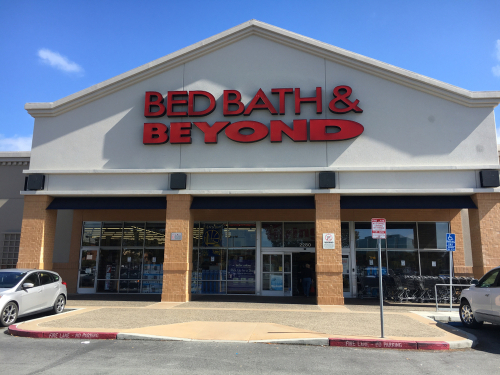Bed Bath & Beyond’s Name Still Carries Weight – If It Could Only Stick With The One
If it’s possible, Bed Bath & Beyond may have gone both too far beyond and not far enough.
As the retailer has struggled with flat sales, falling profit margins and a general berating from shareholders and analysts alike, it has had to face the fact that it is no longer a darling of retailing the way it was for much of its history.
At one time, many industry observers and pundits – including this one – thought Bed Bath & Beyond was among the best retailers in America. It had grown rapidly, wiping out an entire class of competitors, including arch-rival Linens ‘n Things; its balance sheet was impeccable; and it had achieved cultural icon status, even getting the supreme pop compliment of being parodied on The Simpsons (as a gun store called Blood Bath & Beyond).
Bed Bath & Beyond seemed to have limitless horizons.
What happened? Certainly, as with many great physical retailers, the rise of the internet came on faster and more ferociously than virtually anybody predicted, and BBB was caught flat-footed more so than others. It has yet to catch up.
But to blame the internet for all of the company’s woes is not telling the entire story. Recent criticisms have ticked off a list of problems: too many stores, too many stores in need of updates and remodeling, an overloaded merchandising scheme in an era when the endless aisle is just a click away on a device in your hand, and a general failure to find the right mix of exclusive and enticing products on its selling floor. Management really hasn’t argued with any of those conclusions.
But while there’s general agreement that the company hasn’t gone far enough beyond its original roots, there is less attention to its efforts to go beyond the mothership itself. And that is something you can argue is every bit as responsible for the predicament the company finds itself in today.
Bed Bath & Beyond now operates retail operations under a bewildering assortment of multiple nameplates, often with limited overlap. Besides BBB, they include: buybuy Baby, for the infant and juvenile market; Harmon Beauty, a health and beauty aid discounter; Face Values, a Harmon store twin with a different name over the front door; Christmas Tree Shops, a poorly named close-out/treasure hunt model that is a Home Goods wannabe; And That!, another twin, this one to Christmas Tree; Cost Plus and/or World Market, an acquisition that already had doppelgänger naming issues; and One Kings Lane, a onetime flash-sale site testing physical locations.
There are also selected one-offs and assorted mash-up names, including Face Values & Beyond and Christmas Tree Shops … And That! An itinerant shopper could no doubt find even more with a little footwork.
If the dizzying collection of stores strikes you as a bit overwhelming, you’re probably not alone. The fact of the matter is that virtually no modern American retailing corporation has ever successfully operated so many different and often disparate branded operations at the same time.
The closest example was the old Melville Corp., a retail conglomerate that grew out of a shoe retailing base – remember Thom McAn? – and eventually topped out at more than 7,000 individual retail locations, encompassing everything from CVS to Marshalls to KB Toys to This End Up to the aforementioned Linens ’n Things.
By the early 1990s, with plenty of underperforming divisions and Wall Street getting antsy, it started to deconstruct itself, eventually ending up as CVS.
And while Melville was far larger than BBB, in both scale and scope, its vast assortment of nameplates certainly proved to be a problem for management.
The same thing happened when Kmart started accumulating additional retail operations, mostly in the 1980s. They included Sports Authority, Builders Square, Borders, Waldenbooks and Pace Membership Warehouse Clubs. If the names don’t ring a bell, it’s because all have gone out of business, some while Kmart-owned, others after they had been pawned off on others.
If you can’t think of any other retail operators that have tried to run multiple businesses in parallel shopping universes, it’s because that may be the complete and entire list.
And that is one of the difficulties Bed Bath & Beyond has had to manage. While some of the back-of-the-office functions have been consolidated, there are still way too many moving parts in this configuration for things not to go wrong.
Critics are telling BBB to close stores, refresh the ones it will continue with, pare down the assortments in store, and get its online act together. Those are all things that need to happen. But perhaps added to that list is the need to slice off some of the excess nameplate baggage.
By focusing on a more edited – dare one say curated? – store brand lineup and more aggressively getting those units up to their fighting weight, the parent company’s resources could be more focused and concentrated in the most productive areas. Rather than endless one-offs and store test roll-outs, we could see the true merchandising might of a company that still has much to offer.

